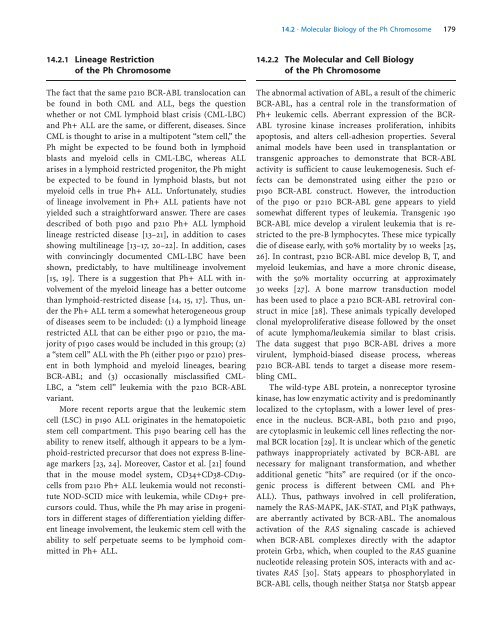Acute Leukemias - Republican Scientific Medical Library
Acute Leukemias - Republican Scientific Medical Library
Acute Leukemias - Republican Scientific Medical Library
Create successful ePaper yourself
Turn your PDF publications into a flip-book with our unique Google optimized e-Paper software.
a 14.2 · Molecular Biology of the Ph Chromosome 179<br />
14.2.1 Lineage Restriction<br />
of the Ph Chromosome<br />
The fact that the same p210 BCR-ABL translocation can<br />
be found in both CML and ALL, begs the question<br />
whether or not CML lymphoid blast crisis (CML-LBC)<br />
and Ph+ ALL are the same, or different, diseases. Since<br />
CML is thought to arise in a multipotent “stem cell,” the<br />
Ph might be expected to be found both in lymphoid<br />
blasts and myeloid cells in CML-LBC, whereas ALL<br />
arises in a lymphoid restricted progenitor, the Ph might<br />
be expected to be found in lymphoid blasts, but not<br />
myeloid cells in true Ph+ ALL. Unfortunately, studies<br />
of lineage involvement in Ph+ ALL patients have not<br />
yielded such a straightforward answer. There are cases<br />
described of both p190 and p210 Ph+ ALL lymphoid<br />
lineage restricted disease [13–21], in addition to cases<br />
showing multilineage [13–17, 20–22]. In addition, cases<br />
with convincingly documented CML-LBC have been<br />
shown, predictably, to have multilineage involvement<br />
[15, 19]. There is a suggestion that Ph+ ALL with involvement<br />
of the myeloid lineage has a better outcome<br />
than lymphoid-restricted disease [14, 15, 17]. Thus, under<br />
the Ph+ ALL term a somewhat heterogeneous group<br />
of diseases seem to be included: (1) a lymphoid lineage<br />
restricted ALL that can be either p190 or p210, the majority<br />
of p190 cases would be included in this group; (2)<br />
a “stem cell” ALL with the Ph (either p190 or p210) present<br />
in both lymphoid and myeloid lineages, bearing<br />
BCR-ABL; and (3) occasionally misclassified CML-<br />
LBC, a “stem cell” leukemia with the p210 BCR-ABL<br />
variant.<br />
More recent reports argue that the leukemic stem<br />
cell (LSC) in p190 ALL originates in the hematopoietic<br />
stem cell compartment. This p190 bearing cell has the<br />
ability to renew itself, although it appears to be a lymphoid-restricted<br />
precursor that does not express B-lineage<br />
markers [23, 24]. Moreover, Castor et al. [21] found<br />
that in the mouse model system, CD34+CD38-CD19cells<br />
from p210 Ph+ ALL leukemia would not reconstitute<br />
NOD-SCID mice with leukemia, while CD19+ precursors<br />
could. Thus, while the Ph may arise in progenitors<br />
in different stages of differentiation yielding different<br />
lineage involvement, the leukemic stem cell with the<br />
ability to self perpetuate seems to be lymphoid committed<br />
in Ph+ ALL.<br />
14.2.2 The Molecular and Cell Biology<br />
of the Ph Chromosome<br />
The abnormal activation of ABL, a result of the chimeric<br />
BCR-ABL, has a central role in the transformation of<br />
Ph+ leukemic cells. Aberrant expression of the BCR-<br />
ABL tyrosine kinase increases proliferation, inhibits<br />
apoptosis, and alters cell-adhesion properties. Several<br />
animal models have been used in transplantation or<br />
transgenic approaches to demonstrate that BCR-ABL<br />
activity is sufficient to cause leukemogenesis. Such effects<br />
can be demonstrated using either the p210 or<br />
p190 BCR-ABL construct. However, the introduction<br />
of the p190 or p210 BCR-ABL gene appears to yield<br />
somewhat different types of leukemia. Transgenic 190<br />
BCR-ABL mice develop a virulent leukemia that is restricted<br />
to the pre-B lymphocytes. These mice typically<br />
die of disease early, with 50% mortality by 10 weeks [25,<br />
26]. In contrast, p210 BCR-ABL mice develop B, T, and<br />
myeloid leukemias, and have a more chronic disease,<br />
with the 50% mortality occurring at approximately<br />
30 weeks [27]. A bone marrow transduction model<br />
has been used to place a p210 BCR-ABL retroviral construct<br />
in mice [28]. These animals typically developed<br />
clonal myeloproliferative disease followed by the onset<br />
of acute lymphoma/leukemia similar to blast crisis.<br />
The data suggest that p190 BCR-ABL drives a more<br />
virulent, lymphoid-biased disease process, whereas<br />
p210 BCR-ABL tends to target a disease more resembling<br />
CML.<br />
The wild-type ABL protein, a nonreceptor tyrosine<br />
kinase, has low enzymatic activity and is predominantly<br />
localized to the cytoplasm, with a lower level of presence<br />
in the nucleus. BCR-ABL, both p210 and p190,<br />
are cytoplasmic in leukemic cell lines reflecting the normal<br />
BCR location [29]. It is unclear which of the genetic<br />
pathways inappropriately activated by BCR-ABL are<br />
necessary for malignant transformation, and whether<br />
additional genetic “hits” are required (or if the oncogenic<br />
process is different between CML and Ph+<br />
ALL). Thus, pathways involved in cell proliferation,<br />
namely the RAS-MAPK, JAK-STAT, and PI3K pathways,<br />
are aberrantly activated by BCR-ABL. The anomalous<br />
activation of the RAS signaling cascade is achieved<br />
when BCR-ABL complexes directly with the adaptor<br />
protein Grb2, which, when coupled to the RAS guanine<br />
nucleotide releasing protein SOS, interacts with and activates<br />
RAS [30]. Stat5 appears to phosphorylated in<br />
BCR-ABL cells, though neither Stat5a nor Stat5b appear
















